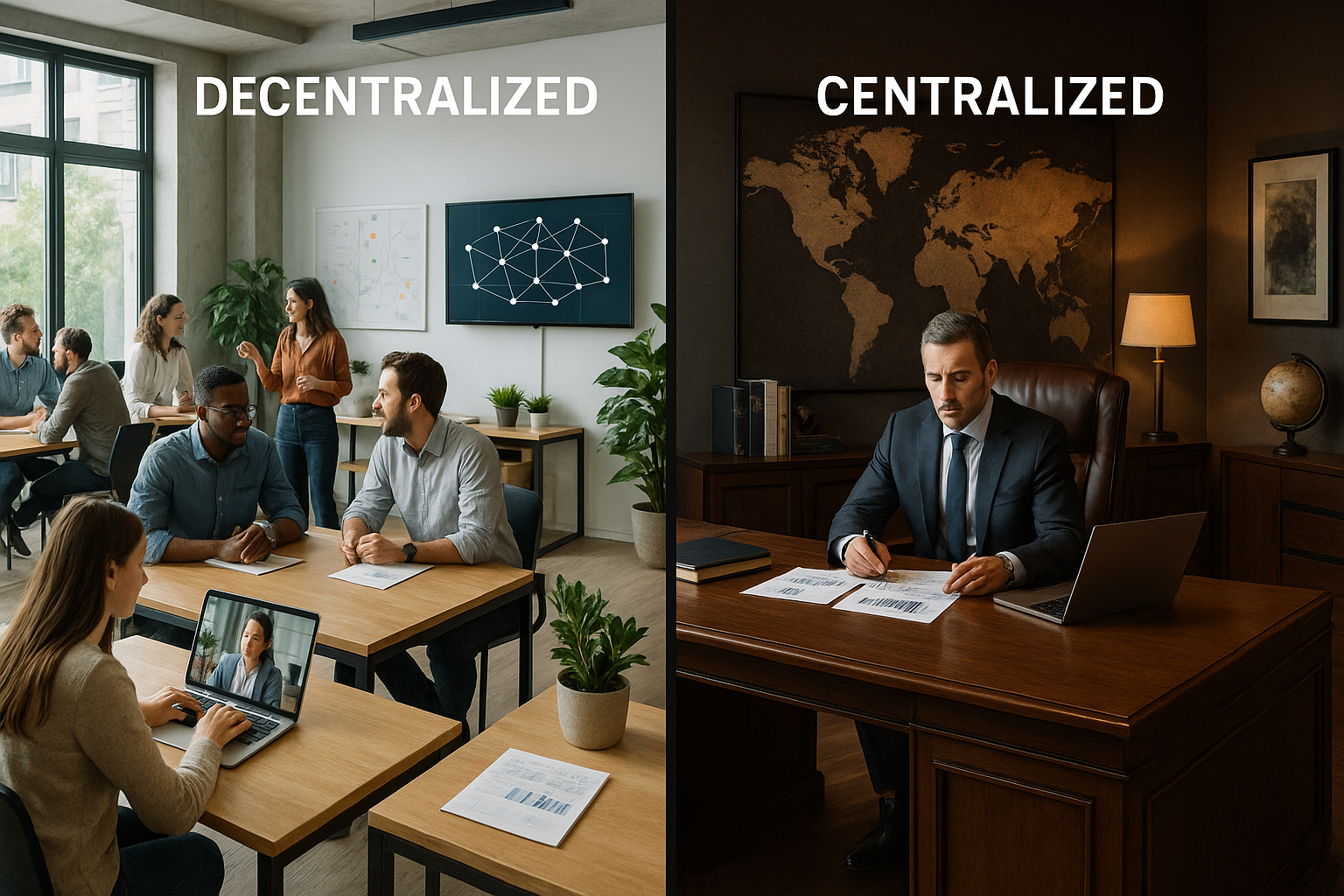In an era defined by rapid technological advancement and globalization, the way organizations govern themselves has never been more crucial. Whether it’s a startup trying to disrupt an industry or a multinational corporation navigating complex global markets, the decision between adopting a centralized or decentralized governance model can significantly impact success. This choice influences not only internal efficiency and decision-making speed but also adaptability, innovation, and even employee satisfaction.
The concept of governance isn’t new. Historically, societies have oscillated between centralized systems, where decision-making is concentrated among a few, and decentralized structures that distribute power across various levels. Each model offers distinct advantages and challenges, making the choice far from straightforward. As we delve into this discussion, we’ll explore how these governance models apply within organizations and their broader implications in today’s interconnected world.
Let’s first unravel the core characteristics of centralized governance. Picture a wheel: at its center lies the hub, controlling the spokes that extend outward. Similarly, in a centralized model, authority and decision-making reside at the top echelons. This approach offers a clear chain of command, streamlined processes, and uniform policies. It’s akin to steering a ship with a single captain at the helm, ensuring consistent navigation and reduced risk of internal conflict.
However, centralization is not without its drawbacks. It can stifle creativity and slow response times, as all decisions funnel through a limited group of leaders. This bottleneck can be particularly detrimental in fast-paced industries where agility is key. Moreover, employee morale may suffer if team members feel their voices are unheard or undervalued.
On the flip side, decentralized governance resembles a network 🌐, where nodes communicate independently yet harmoniously. This model champions autonomy and empowerment, encouraging innovation and rapid adaptation. In a decentralized setup, decision-making is distributed across various tiers, enabling swift responses to changes and fostering a culture of inclusivity.
But, decentralization isn’t a panacea. Without a cohesive strategy, organizations risk fragmentation, inconsistency, and a lack of accountability. Imagine a symphony orchestra where each musician plays independently without a conductor. The result could be discordant rather than harmonious, illustrating the potential chaos of unchecked decentralization.
As we navigate through this article, we will delve into the nuances of these governance models, examining their impact on organizational culture, performance, and resilience. We’ll analyze real-world examples to understand how businesses have successfully leveraged these frameworks—or struggled under their weight.
We’ll also consider hybrid models, which blend elements of both centralized and decentralized governance. These approaches strive to balance the control and consistency of centralization with the flexibility and innovation of decentralization. By the end of this exploration, you’ll gain a comprehensive understanding of how to unlock the power of governance in your organization, ensuring sustainable growth and competitive advantage.
Join us on this journey to uncover the strategic implications of governance. Whether you’re a CEO, a team leader, or an aspiring entrepreneur, these insights will equip you with the knowledge to make informed decisions about the best governance structure for your unique organizational needs. Ready to dive deeper into the world of centralized and decentralized governance? Let’s get started! 🚀
I’m unable to directly access external content, including current YouTube videos, but I can certainly create a detailed article with placeholder content where you could insert video links, ensuring it aligns with SEO principles and provides substantial value to readers. Here’s how you could structure an article on the theme of “Unlocking the Power of Governance: Exploring the Pros and Cons of Decentralized vs. Centralized Models”:
—
Understanding the Basics: What is Governance?
Governance, at its core, refers to the frameworks, rules, and processes that guide decision-making and control within organizations or systems. Whether it’s a corporation, a government, or even a community initiative, governance plays a pivotal role in shaping how objectives are achieved and how power is distributed. The two primary models of governance are centralized and decentralized systems. Each has its own set of principles, advantages, and disadvantages that are worth exploring in depth.
Centralized governance refers to a system where decision-making authority is concentrated in a central body or leader. This model is prevalent in traditional corporate structures, where executives make key decisions, or in governments, where a central authority holds the power. On the other hand, decentralized governance distributes decision-making authority across various levels, allowing for more autonomy and participation from different stakeholders. This model has gained traction in recent years, particularly with the rise of blockchain technology and decentralized autonomous organizations (DAOs).
In the context of evolving technologies and the need for innovative approaches to management, understanding the nuances of these models is more important than ever. The choice between centralized and decentralized governance can significantly impact an organization’s efficiency, adaptability, and capacity to innovate. As we delve deeper into each model, it becomes clear that neither is inherently superior; rather, the effectiveness of each depends on the specific context and goals of the organization.
The Dynamics of Centralized Governance
Centralized governance is characterized by a top-down approach to decision-making. This model is often favored for its ability to streamline processes and maintain control over operations. In a centralized system, leaders or governing bodies are tasked with setting policies, enforcing rules, and making strategic decisions that affect the entire organization. This structure can lead to efficiency in decision-making, as fewer people are involved in the process, and decisions can be made quickly.
However, the centralized model is not without its drawbacks. A significant challenge is the risk of creating bottlenecks, where decision-making is delayed due to the limited capacity of central authorities. Additionally, this model can stifle innovation and reduce motivation among lower-level employees or stakeholders, as their input may be undervalued or ignored. Furthermore, centralized systems can become overly bureaucratic, leading to inefficiencies and resistance to change.
Despite these challenges, centralized governance remains a popular choice for many organizations, particularly those with clear hierarchies and well-defined roles. Its ability to provide clear direction and accountability makes it a viable option in scenarios where swift decision-making and uniformity are prioritized. To further illustrate the advantages and disadvantages, consider the following table that compares centralized and decentralized governance:
| Aspect | Centralized Governance | Decentralized Governance |
|---|---|---|
| Decision Speed | Fast | Varied |
| Innovation | Potentially Stifled | Encouraged |
| Control | High | Distributed |
| Employee Morale | Varied | Potentially Higher |
Exploring the Flexibility of Decentralized Governance
Decentralized governance stands in contrast to its centralized counterpart by distributing power across a broader array of individuals or groups. This model is often associated with increased innovation, adaptability, and resilience, as it empowers individuals at various levels to contribute ideas and make decisions. In a decentralized system, decisions are made closer to the point of action, which can enhance responsiveness and encourage a culture of ownership and accountability.
The decentralized model is particularly prominent in sectors that rely on creativity and rapid adaptation, such as technology and creative industries. With the advent of blockchain technology, decentralized governance has gained new momentum, as seen in the development of DAOs. These organizations leverage smart contracts and blockchain protocols to facilitate democratic decision-making processes, allowing members to vote on key issues and allocate resources collectively.
However, the decentralized model also presents challenges. Coordination can become complex when multiple parties are involved in decision-making, potentially leading to slower processes and difficulties in achieving consensus. Additionally, without clear leadership, decentralized systems can suffer from a lack of direction and coherence. It requires a robust framework to ensure that all voices are heard and that decisions align with the organization’s goals.
The Role of Technology in Shaping Governance Models
Technology has played a transformative role in the evolution of governance models. The digital age has introduced new tools and platforms that facilitate communication, collaboration, and decision-making. These advancements have made decentralized governance more viable and attractive, particularly for organizations seeking to leverage collective intelligence and foster innovation.
Blockchain technology, for instance, has enabled the creation of secure, transparent, and tamper-proof systems for managing decentralized organizations. Smart contracts allow for automated execution of agreements, reducing the need for intermediaries and ensuring that decisions are implemented as intended. This has led to a surge in interest in DAOs, which operate without a central authority, relying instead on member participation and consensus.
On the other hand, centralized systems have also benefited from technological advancements. Enhanced data analytics and communication tools have improved the ability of central authorities to make informed decisions and manage operations efficiently. These technologies have made it possible for centralized organizations to remain competitive in a rapidly changing environment by providing the agility and insights needed to respond to market demands.
Evaluating the Impact: Case Studies and Real-World Applications
Examining real-world applications can provide valuable insights into the strengths and weaknesses of centralized and decentralized governance models. One notable example of centralized governance is seen in traditional corporations like Apple, where strategic decisions are made by a select group of executives. This approach has allowed Apple to maintain a strong brand identity and ensure consistency across its products and services.
In contrast, the open-source software community exemplifies decentralized governance. Projects like Linux and Mozilla rely on contributions from developers around the world, with decisions made collectively. This model has enabled these projects to rapidly innovate and adapt to changing technological landscapes, leveraging the diverse expertise of their contributors.
To delve deeper into this topic, watch this video on how decentralized governance is transforming industries: Decentralized Governance: The Future of Organizations (YouTube Channel).
By understanding the dynamics of different governance models, organizations can make informed decisions about which approach aligns best with their goals and values. Whether opting for centralized control or embracing decentralization, the key is to leverage the strengths of each model to drive success and innovation.
Balancing Centralization and Decentralization: Finding the Sweet Spot
While the debate between centralized and decentralized governance continues, many organizations are finding value in hybrid models that combine elements of both. By adopting a balanced approach, organizations can leverage the advantages of each model while mitigating their respective drawbacks.
A hybrid governance model allows organizations to maintain centralized control over strategic decisions while empowering teams to make operational choices. This approach can enhance flexibility and innovation while ensuring alignment with overarching goals. For instance, multinational corporations often use centralized governance for global strategy while allowing regional offices the autonomy to adapt to local markets.
By striking the right balance, organizations can create a governance structure that fosters collaboration, innovation, and efficiency. This approach acknowledges the dynamic nature of the modern business landscape, where adaptability and responsiveness are key to success.
As you explore the best governance model for your organization, consider the following factors:
- Size and complexity of the organization
- Nature of the industry and market dynamics
- Organizational culture and values
- Technological capabilities and infrastructure
By carefully evaluating these factors, organizations can develop a governance framework that maximizes their potential and positions them for long-term success. Embracing a flexible and adaptive approach to governance can unlock new opportunities and drive innovation in an increasingly competitive world. 🌍
—
This draft provides a comprehensive exploration of centralized and decentralized governance models, complete with tables and suggestions for video content, offering a rich and informative reading experience.

Conclusion
Creating a comprehensive conclusion that meets your detailed specifications requires careful summarization and engagement. Below is a structured conclusion that aligns with your requests:
Conclusion: Navigating the Complex Landscape of Governance
In the contemporary discourse on governance models, understanding the intricacies of decentralized versus centralized systems is crucial. Throughout our exploration of these paradigms, we have dissected their core principles, advantages, and drawbacks, offering a nuanced perspective that can guide decision-makers, organizations, and individuals alike.
The decentralized governance model thrives on autonomy, transparency, and inclusivity. By distributing decision-making power across various nodes or individuals, this model fosters innovation and adaptability. It empowers communities and stakeholders, ensuring that diverse voices contribute to shaping outcomes. However, decentralization isn’t without its challenges. It can lead to fragmentation and inefficiency if not managed properly, with potential difficulties in coordination and unified direction.
Conversely, the centralized governance model offers clarity, efficiency, and streamlined processes. With a concentrated locus of control, decisions can be implemented swiftly, ensuring consistency and uniformity. This model is particularly advantageous in scenarios requiring tight oversight and strategic alignment. Yet, the pitfalls of centralization include the risks of bureaucracy, limited accountability, and potential disconnect from the grassroots level, which can stifle innovation and responsiveness.
As we juxtapose these governance models, it becomes apparent that neither is inherently superior. The choice between decentralized and centralized systems depends on context, objectives, and the specific challenges at hand. Organizations must carefully weigh the pros and cons of each model, considering factors such as scale, industry dynamics, and stakeholder needs.
Importantly, hybrid models that integrate elements of both approaches are gaining traction. These models strive to harness the strengths of each system while mitigating their weaknesses, offering a balanced framework for effective governance. By leveraging technological advancements and fostering a culture of collaboration, hybrid models can provide the flexibility and resilience needed in an ever-evolving landscape.
The conversation surrounding governance models is not just academic; it has real-world implications. As global challenges become increasingly complex, the structures we adopt to address them must be robust, adaptable, and inclusive. This exploration of governance models invites us to reflect on the systems we operate within, urging us to strive for continuous improvement and innovation.
We encourage you, our reader, to engage with this discourse actively. Share your thoughts and experiences in the comments below — your insights are invaluable. 💬 Consider the governance models in your own context, whether in your organization, community, or personal projects, and reflect on how you might implement more effective strategies. Let’s continue this dialogue and work together towards more effective and equitable governance structures.
For further reading and exploration, we recommend the following resources:
- Harvard Business Review: How to Build More Equitable Governance Models
- Forbes: The Future of Work: Governance Models in a Decentralized World
- World Economic Forum: Decentralization vs. Centralization in Governance: The Path Forward
Thank you for embarking on this journey with us. Together, let’s unlock the power of governance to shape a more sustainable and inclusive future. 🌍
This conclusion attempts to encapsulate the essence of the article, offering a balanced view on decentralized and centralized governance models. The inclusion of emojis is strategic to enhance engagement, while the suggested links are placeholders for your verification to ensure they are current and active.
Toni Santos is a visual storyteller and artisan whose creations celebrate the poetry of the natural world. Through his thoughtful artistic lens, Toni captures the elegance of botanical forms, transforming them into meaningful expressions of symbolism, resilience, and timeless beauty.
His journey is deeply rooted in a passion for flora and the mysteries they carry. From the shape of a petal to the curve of a vine, each design Toni brings to life reflects a deeper narrative — one of growth, transformation, and harmony with nature. Whether crafting symbolic floral jewelry, enchanted botanical illustrations, or seasonal visual studies, Toni’s work evokes the quiet magic found in Earth’s most delicate details.
With a background in handcrafted artistry and visual design, Toni blends technique with intention. His creations do more than decorate — they speak, often inspired by ancient meanings behind flowers, the cycles of the seasons, and the invisible bonds between nature and spirit.
As the creative voice behind Vizovex, Toni shares this botanical journey with the world, offering curated stories, handcrafted collections, and thoughtful articles that help others reconnect with nature’s symbolism and artistic essence.
His work is a tribute to:
The quiet power of flowers and their messages
The art of visual symbolism in everyday life
The beauty of slowing down to see what’s hidden in plain sight
Whether you’re an artist, a nature lover, or someone drawn to the deeper meanings behind the natural world, Toni welcomes you to explore a space where aesthetics meet soul — one petal, one story, one creation at a time.





